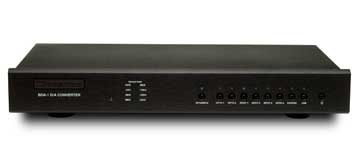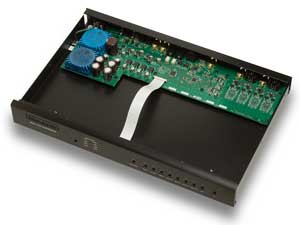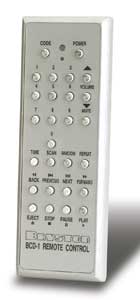| Bryston's
new DAC rules as affordable high-end |
 Few DAC's Can Compete
Few DAC's Can Compete
by David McCallum
Introduction
We all know of Bryston’s accomplishments as a manufacturer of high
quality analog amplification products. They have been at it
for decades, and their most recent SST2 series amplifiers have received
strong praise within the hi-fi community. The new 7B
SST2 mono-block amplifiers received a prestigious four note rating here on TIE’s website.
However, over the last decade Bryston’s most impressive work may
be in the design of dedicated two-channel digital electronics.
History
Bryston’s foray into digital audio began about ten years
ago with the introduction of an internal 96/24 DAC designed
for the BP25 pre-amplifier. Following the internal DAC were
multiple generations of multi-channel surround sound processors
for home theater (SP 1.0, SP 1.7 & SP 2.0). At that time,
much of the world was moving toward all-inclusive products
that handled both video and audio in one unit, prioritizing
convenience of use and connectivity. Bryston, however, made
the decision to exclude video circuitry from their processor
because of the impact it had on the audio performance. By successfully
pairing digital audio decoding with high quality analog output
circuits, Bryston’s processors quickly became known for
their uncompromising sound quality.
Moving forward a few years, with the electronics world in the
middle of a battle between high-definition media formats, and
with many hi-fi enthusiasts exploring computer-based music,
Bryston made another curious decision; they designed a CD player – investing
substantial resources into a format that many consider to be
dying. The result was the BCD 1 compact disc player.
Not coincidentally, in one unique aspect the BCD 1 mirrored
Bryston’s earlier surround sound processors: simplicity.
The unit only does one thing: it plays Redbook-standard 44.1K-16bit
compact discs. However, it plays them very well. With design
emphasis placed on its dual-discrete class A analog output
stage, Bryston’s first disc player became an instant
hit. Since it’s release in 2007, the BCD 1 has received
worldwide praise and countless awards, and has become the most
successful Bryston product to date.
After investing the resources in developing the BCD 1 CD player,
it was logical for Bryston to further advance their digital
product line. The success of the disc player proved to Bryston
that they had the ability to succeed in the world of stand-alone
digital electronics. According to James Tanner (VP of Sales
and Marketing), Bryston was looking for a product that was
capable of tying multiple digital sources together. The result
is the BDA 1 DAC.
The Sound
Let me tell you a story. The Bryston BDA 1 arrived on a Sunday
afternoon in mid-December after I had spent an extensive weekend
testing RCA interconnect cables. As the day moved on I pushed
my cable testing to the limit and was due to leave the house.
By then, I had probably logged 20 hrs of listening over the
weekend and was pretty spent on hi-fi, but felt a pull to at
least hook up the BDA 1.
Using Alan Parsons & Stephen Court’s Test Disc Two
reference CD for about the 30th time that weekend, I set the
system to my regular listening level, ran a few tests and finally
skipped down to the instrument cues. While listening first
to a solo piano then a few guitar tracks I found myself a bit
disoriented; the whole system sounded quite different. I was
only a few seconds into Limelight by The Alan Parsons Project
when my enthusiasm started to build. Something big was happening
here.
Knowing that I was under some pressure to get out of the house,
I couldn’t resist trying one more song. Into my player
went Abbey Road. Selecting track seven and knowing the volume
was perfect, I sat back with my eyes closed. I smiled as the
opening guitar in Here Comes the Sun began to pour gently from
the left channel of my ATC SCM 20 loudspeakers. By the time
the song spread across the room and George Harrison’s
voice rang out, I knew something very special had entered my
system.
 Following a weekend of cable testing in which I found myself
straining to find even minute differences, this new component
was quite simply a game changer. Differences were no longer
subtle, improvements were no longer debatable and the overall
sound quality had leaped forward a multitude of degrees. For
the rest of that night and the next day my time was split between
raving about what I had heard and anticipating when I would
get to play with the BDA 1 again. Following a weekend of cable testing in which I found myself
straining to find even minute differences, this new component
was quite simply a game changer. Differences were no longer
subtle, improvements were no longer debatable and the overall
sound quality had leaped forward a multitude of degrees. For
the rest of that night and the next day my time was split between
raving about what I had heard and anticipating when I would
get to play with the BDA 1 again.
My next opportunity had to wait a full 24 hrs. Arriving home
from work, I slid past my lovely wife who had already started
cooking dinner. She knew where I was headed and graciously
let me pass down into my hi-fi den.
While waiting for the tubes on my Modwright LS 36.5 preamp
to warm up I figured out the BDA 1’s next test: how would
Bryston’s DAC compare to SACD? I’m an avid SACD
enthusiast, one of a dying breed I know, but I have remained
a hold out. So for the next go-round I planned to play three
different stereo SACD tracks, level match the system and switch
to the CD layer. The BCD 1 adds about 2-3 db of gain to the
system, which is a massive difference if not accounted for
with a volume trim.
The tracks I planned to use were Here We Go Again by Ray Charles & Norah
Jones, Ring them Bells by Bob Dylan and The Pink Panther Theme
by Henry Mancini. I started with Here We Go Again on SACD.
It sounded as I expected: lush, full and spacious. However,
after just one track I wanted to get right to the test and
switch to the CD layer.
“WOW” I must have yelled, probably more than once.
What sounded good before now leapt from the speakers, breathing
life and space into the room where none had been before. Clarity,
detail, bass response, high frequency extension, depth, dynamic
range, and imaging…you name the sonic attribute and
the improvements were obvious. I ended up listening to about
6-8 tracks in each format, and as amazed as I was there really
was no comparison between the SACD layer and the 44.1k-16b
Redbook layer. The BCD 1 remained a game changer.
Responding to my constant outbursts my wife climbed down the
stairs and pronounced, “You’ve got 4 minutes to
wow me.” While not an audiophile, Natalie is a real music
enthusiast who willingly participated in much of my weekend
cable testing. As a result, she was quite versed in the system’s
sound, and, I think, skeptical of my ravings about the BDA
1.
Under pressure to make a quick impression, I eagerly put Abbey
Road back into the CD player and again skipped down to track
seven. As the guitar began I noticed a smile creep across her
face, and after about 30 seconds, right around the time George
crooned “little darlin’’’ for the first
time, Natalie turned and said, “you weren’t kidding.”
Abandoning any comparisons to SACD or cables, we simply enjoyed
each song as if it were a new discovery. The Beatles, Van Morrison,
Ray Charles, Norah Jones, Lyle Lovett, Dire Straits, The Chieftains,
Bob Dylan, U2, Neko Case and Oscar Peterson all got their fair
share. Near the end of the session, as the 50th anniversary
of Miles Davis’ Kind of Blue reached its final notes
Natalie leaned over and said, “I hope this never leaves.” The
BDA 1 had announced its presence, and it was here to stay.
Conclusion
I know the previous part of this review read more like a story
than a technical analysis. I’ve left out comparisons
to other DACs, explanations of attributes like upsampling and
evaluations of its performance on different types of music.
However, I found myself having so much fun listening to music
through the BDA 1 that my experience seemed best expressed
as a narrative. But I will add a few bits of hi-fi related
info for those who are curious.
The most exceptional quality of the BDA 1 is its overall musicality.
The DAC sounds very sweet, with warmth not often attributed
to digital audio. However, that warmth does not come at the
sacrifice of accuracy. There is an exceptional level of separation
between channels, resulting in a very high level of detail
across the entire sonic spectrum. Highs are crisp and clear
without bite, the midrange has the full space it requires,
and bass & depth are uncompromised. My instinct is that
these attributes are directly related to the quality of the
design in the analog output stage.
I have spent a lot of time listening to Bryston equipment.
I own a 9B SST amplifier, and through my affiliation with TIE
have listened to most products they have manufactured in the
last decade. This relatively inexpensive DAC ranks with the
best components Bryston has produced. As I’m sure you
can tell, I’ve thoroughly enjoyed my time with the BDA
1. It is an exceptionally good product, and would probably
earn the same level of praise if it cost three times as much.
But it doesn’t. Whether you choose to evaluate it based
on design, functionality, sound or price, the BDA 1 is a winner.
|
| MODELS |
MANUFACTURER |
| Bryston BDA 1 Digital to Analog Converter |
Bryston Ltd. |
| RATING |
CONTACT |
♪♪♪♪
|
BRYSTON LTD.
677 NEAL DRIVE
PETERBOROUGH, ONTARIO
CANADA
K9J 6X7
PHONE: 705 742-5325
www.bryston.com
|
| PRICE |
|
| Dimensions |
|
|
 |
TECHNOLOGY
Bryston’s BDA 1 DAC is an external stereo digital-to-analog
converter. It is capable of converting numerous digital input
signals (from 32k-16bit to 192k-24bit) via eight selectable
inputs options and six input types (USB, 2 COAX, 2 OPTICAL,
AES-EBU, 2 BNC). The analog signal is output via unbalanced
RCA or fully differential balanced XLR connectors.
Inside the box, the BDA 1 employs a discrete, dual mono design
with completely separate digital and analog signal paths. It
starts with impedance matching transformers that provide optimum
termination of the incoming digital data stream. The signal
also passes through both a re-sampling and re-clocking process
in order to reduce jitter.
Jitter is a nasty attribute of digital audio transmission,
the result of mistiming of the data as it moves between two
points in the audio chain. By providing a re-sampled & re-clocked
signal to the DAC chips, the BDA 1 is able to greatly reduce
the effects of jitter in the audible signal.
Finally, two independent 192k/24bit Crystal CS-4398 DAC chips
are used to perform the conversion from digital to analog.
The analog signal now moves through two completely separate
analog audio chains. Each chain uses its own independent linear
power supply, has a separate ground plan, and a fully discrete,
class-A proprietary analog output amplifier circuit.
There are a few more relevant features, such as user selectable
up-sampling (176.4k & 192k), transformer coupled SPDIF & AES
EBU digital inputs, and SPDIF COAX bypass loop output, but
at this point I’m more interested in wrapping up the
technical garble and getting onto what really matters, which
is how the BDA 1 sounds. |
|
